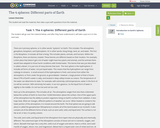
The student wil read the material, then take a quiz with questions from the material.
- Subject:
- Environmental Science
- Material Type:
- Lesson Plan
- Author:
- Jack Hudson
- Amy Pace
- Date Added:
- 03/14/2019

The student wil read the material, then take a quiz with questions from the material.

Lesson resources and assignment related to Historical Earthquakes.

NGSS: MS-LS1-3: Lesson following a Gather, Reason, Communicate format for middle to high school science course.

In this assignment, you will conduct an experiment to simulate the greenhouse effect and global warming. You will be recording and graphing your results.

Objective: Students will conduct an experiment in order to determine how temperature and salinity affect the density of water. This assignment will ask you to conduct a simple experiment to determine how temperature and salinity affect the density of water while filling out a worksheet.

Charles Darwin accumulated a tremendous collection of facts to support the theory of evolution by natural selection. One of his difficulties in demonstrating the theory, however, was the lack of an example of evolution over a short period of time, which could be observed as it was taking place in nature. Although Darwin was unaware of it, remarkable examples of evolution, which might have helped to persuade people of his theory, were in the countryside of his native England. One such example is the evolution of the peppered moth Biston betularia.
The economic changes known as the industrial revolution began in the middle of the eighteenth century. Since then, tons of soot have been deposited on the country-side around industrial areas. The soot discoloured and generally darkened the surfaces of trees and rocks. In 1848, a dark-coloured moth was first recorded. Today, in some areas, 90% or more of the-peppered moths are dark in colour. More than 70 species of moth in England have undergone a change from light to dark. Similar observations have been made in other industrial nations, including the United States.